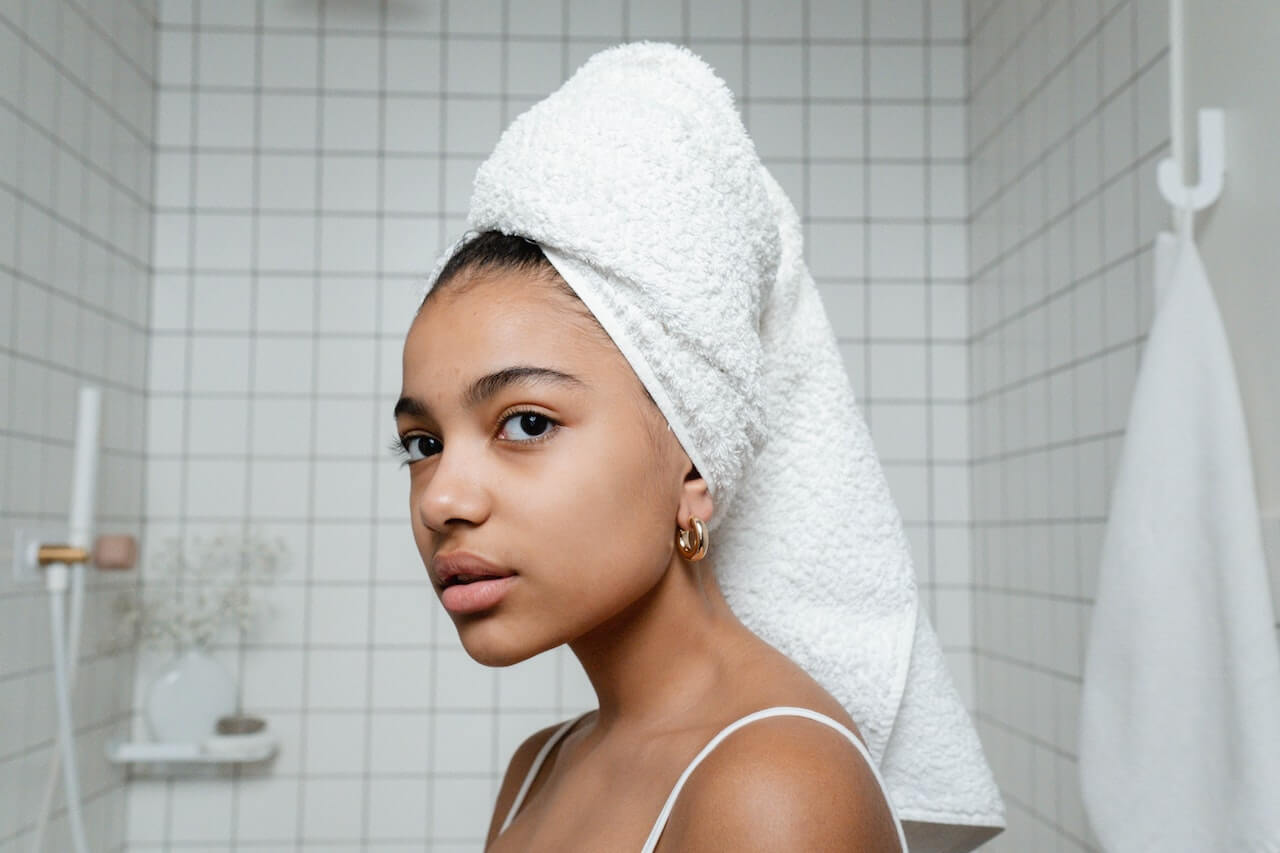As the decades go by and you note your hair shifting colors and the crinkles of crow's feet appearing, another change might be harder to pinpoint: A hairline on the move. If you've noticed thinning hair around the temples or your widow's peak looks more prominent than usual, you might be experiencing the beginning stages of a receding hairline.
Men typically experience a prominent receding hairline, but women can also share it. To understand the science behind a receding hairline and find out if there's any way to stop the process or slow it down, we spoke to a dermatologist and took a closer look at the symptoms. Read on for more — plus, find out what all-natural products you really should be using to support healthier, fuller, thicker looking hair.
What Is a Receding Hairline, and How Does It Occur?
It's perfectly normal to lose hair as you age. But a receding hairline can feel quite different. Instead of losing more hair from across your scalp, the signs show mainly around the temples, and you might notice an obvious change in the shape of your hairline.
A receding hairline or pattern hair loss is often hereditary and more common for men, but both sexes can experience the condition. An uneven hairline in men doesn't necessarily signal a receding hairline. A mature hairline might look higher on the forehead and indent around the temples but does not necessarily preempt a receding hairline.
Dermatologist Dr. Sanober Pezad explained to VEGAMOUR, "A receding hairline can be attributed to multifactorial origins. From a person's age, gender, ethnicity and environment to ... an individual's underlying genetic susceptibility — [all] play a role in receding hairlines."
Shop: VEGAMOUR Products for Men
Factors That Contribute to a Receding Hairline
Many factors can contribute to a receding hairline, including:
- Genetics. Pattern baldness can be inherited from either your mother or your father, and women usually experience a high hairline around middle age. Of course, menopause also occurs around this age, causing hormonal changes that potentially trigger excessive hair loss.
- Stress. A stressful period can sometimes impact the fullness of a normal hairline. A condition called telogen effluvium can occur when the body is under pressure, which means many hair follicles are pushed into the resting stage of the hair growth cycle, meaning no new hair is produced. This hair shedding is often temporary and will usually improve over time.
- Pregnancy. Hair loss in pregnancy is considered entirely normal and can trigger a changing hairline as hormone levels fluctuate. Again, this hair loss is temporary and usually evens over time.
- Using harsh chemicals. You risk damaging the hair follicles if you use harsh chemicals on an already dry scalp. To keep hair gorgeous, full and glossy, make sure you use a gentle but powerful all-natural shampoo and conditioner combination to help revitalize lacking strands.
- A mature hairline. Someone more mature might see their hairline move away from its initial position. Many men will experience this between the age of 17 and 30, and the shift can take up to 10 years.
- Health conditions. A receding hairline in women is essentially frontal fibrosing alopecia, a condition linked to the immune system and hormonal changes. Traction alopecia is another condition that can cause immediately noticeable hair loss.
"The most common cause of receding hairline is androgenetic alopecia (male pattern baldness) and female pattern hair loss, and they are so named as the main cause of this kind of patterned hair loss is an interaction of hormonal influence and a genetic tendency to develop the condition," said Pezad. "It primarily occurs due to the interactions of androgens on the genetically susceptible hair follicles in androgen-dependent areas like the front of the scalp.
Overstyling hair, choosing too-tight hairstyles (such as braiding), use of chemicals such as bleach and smoking cigarettes can also trigger a receding hairline.
Related: Smoking and Hair Loss: Are They Connected?
Different Types of Hairlines
To understand where your hairline naturally falls and how a receding hairline will present, first consider what type of hairline you have.
Low Hairline
Your forehead probably looks smaller if your hairline starts closer to the eyebrow. A receding hairline can be less noticeable in someone with a low hairline because their scalp is less exposed.
Middle Hairline
A middle hairline can also be considered normal, beginning around the upper middle of the forehead. Someone with a middle hairline may experience an M-shaped hairline if they start to recede.
High Hairline
A high hairline tends to begin at the crown of the head, and women and men with this type of hairline will typically show a lot of their forehead if they start to recede. If you have a higher hairline, you might notice it when looking through your family history.
Someone might also have a:
- Triangular hairline: The hairline begins low around the temples.
- Bell-shaped hairline: A U-shape forms around the lowest part of the temples. The U-shape can also be a result of receding.
- Straight-lined hairline: The hairline doesn't follow the natural curve of the head. Instead, it might have 90-degree angles.
- Uneven hairline: The hairline doesn't follow a symmetrical pattern due to things like genetics or overstyling, which can disrupt hair growth.
The Answer to 'Is My Hairline Receding?'
If you're concerned you have a receding hairline, you might notice one or more of the following signs:
- Thinning hair: Pulling out more strands than usual from your drain is one of the first signs of a changing hairline or hair loss.
- Changes in your hairline: You might see more of your forehead than usual or notice an M-shape forming. Thin areas around your temples are also a telltale sign of a receding hairline.
- Changes around your crown: The hair on the top of your scalp might start to thin if you begin to recede. You might also notice more of your scalp underneath overhead lighting.
- Hair is harder to style: If you're struggling to comb hair without pulling out strands, you might be experiencing some changes.
- There's a family history: Compare photos of yourself with those of your parents to see whether your hairlines match up.
How to Halt a Receding Hairline
A maturing hairline usually only moves approximately 1 inch up and away from the forehead, but a receding one moves further back and often has a more defined hairline and a telltale m-shape. Although you can't halt a receding hairline, there are a few things you can do to help slow the process.
Eat a Healthy Diet
A diet rich in antioxidants can help keep your hair looking full and thick and relieve stress. Additionally, foods rich in biotin can also help hair thrive.
Read: Get to Know VEGAMOUR's Supplements
Take a Hair Loss Medication
Finasteride is a prescription medication found to help slow hair loss to help hair. However, prescription hair loss treatments, like finasteride, can have unpleasant side effects. If you prefer a more natural approach, GRO Hair Serum has been clinically proven to support a healthy and balanced follicular ecosystem while soothing the scalp and revitalizing hair roots. The non-greasy serum is formulated with powerful phyto-actives shown in multiple clinical studies to encourage visibly thicker, fuller looking hair and reduce shedding.
Try a New Hairstyle
A new hairstyle can work wonders to diminish the appearance of a receding hairline. Men might buzz-cut their hair to help their hairline blend in with their scalp. Consult with your favorite hairstylist to work out the most flattering look.
Get a Hair Transplant
A hair transplant is a surgical procedure that involves a doctor implanting sections of hair to make the hairline looks fuller and thicker. Hair transplants come with risks, though, so always consult with a reputable doctor.
Related: How Much Is a Hair Transplant? Read This Before Committing
Embracing Change
Unfortunately, there's no proven way to completely stop a receding hairline once the process begins. You might choose to opt for surgery. However, there are steps you can take to keep your hair in the best condition, such as revamping your hair wellness routine and changing up your diet. Considering your hair from a new perspective can help you embrace change. Of course, if you're concerned about your hairline and it starts to impact your state of mind, always check in with a professional for guidance.
#include-related-slider#
More From VEGAMOUR
- What Causes Hair Loss in Women?
- How to Hide Female Hair Thinning in the Front
- How Long Does It Take for Hair to Grow Back?
- How to Handle a Mature Hairline
Photo credit: Rachel Coyne/UnSplash
Back


















